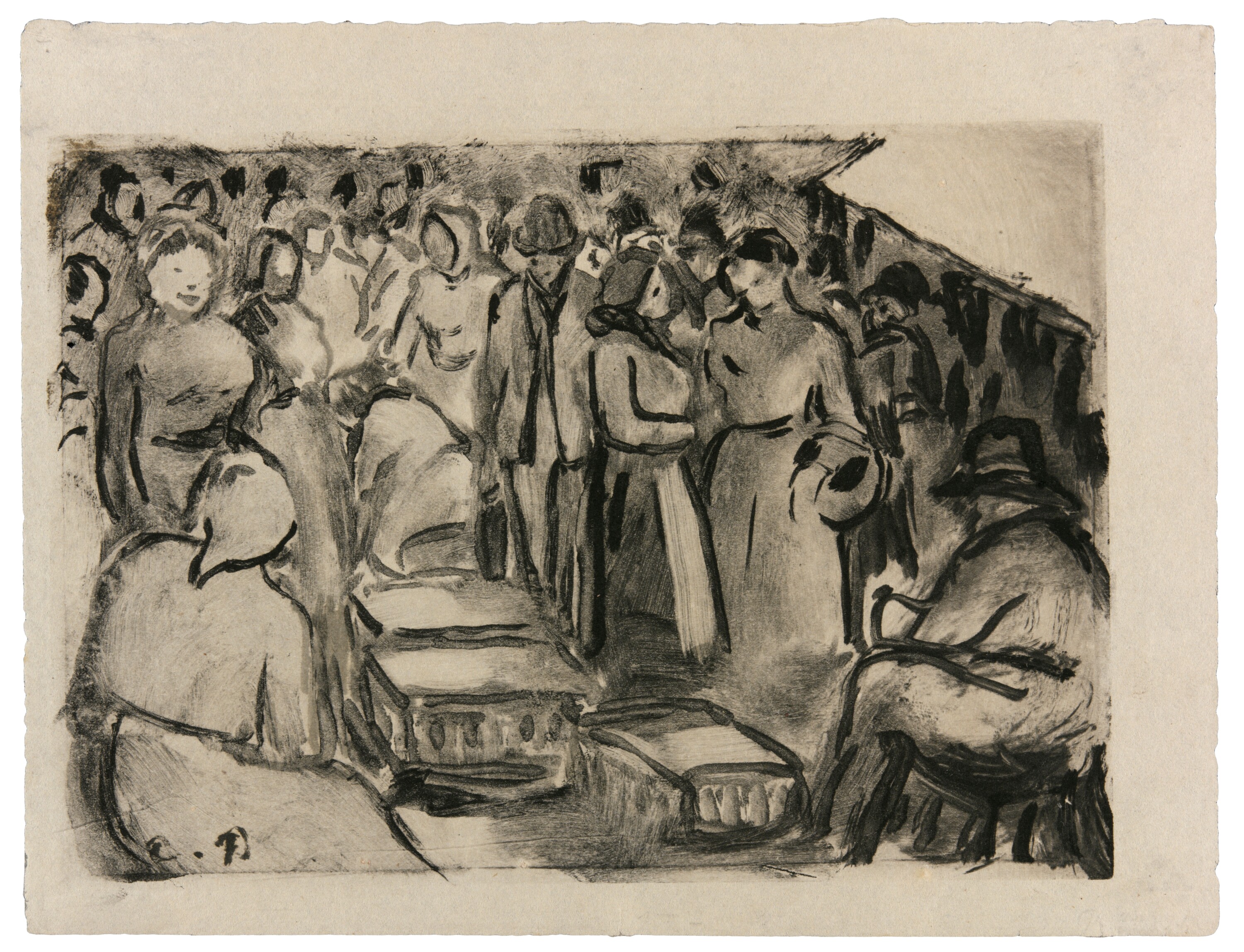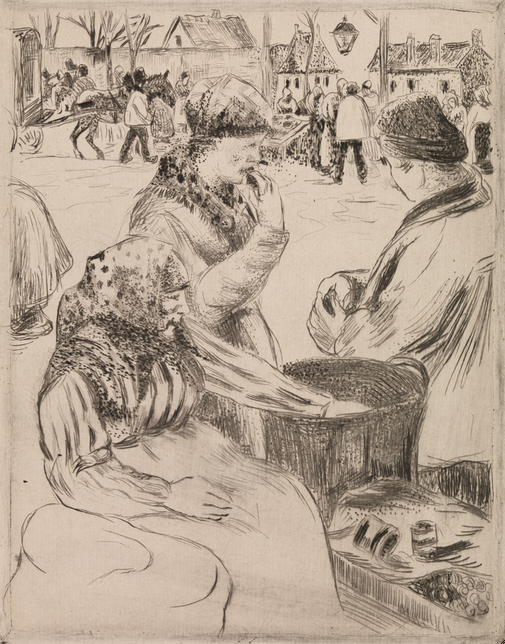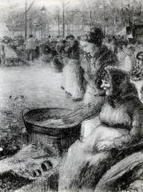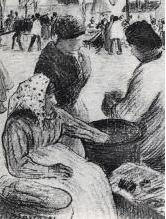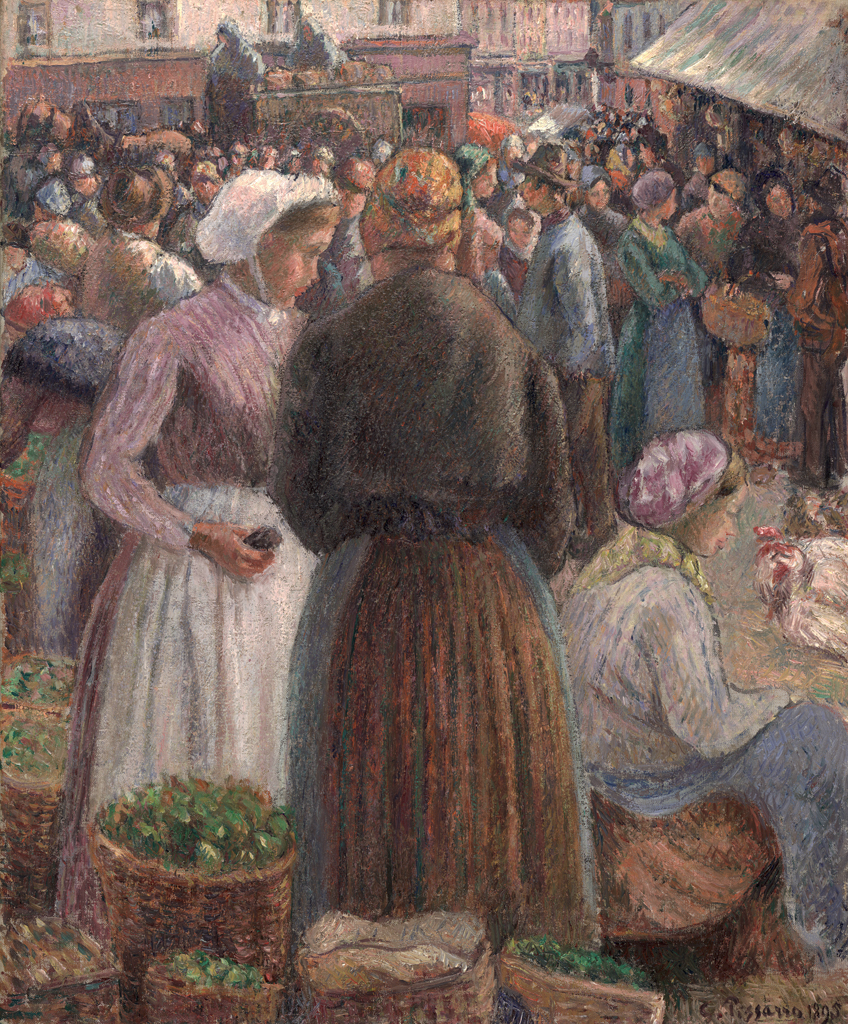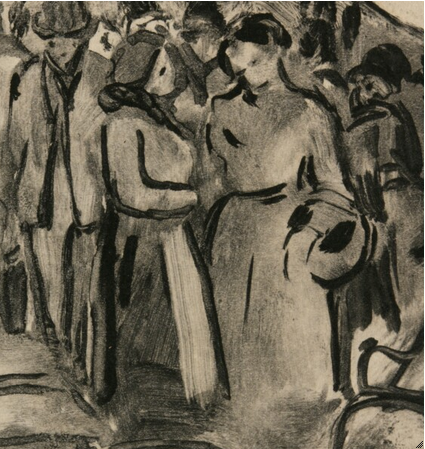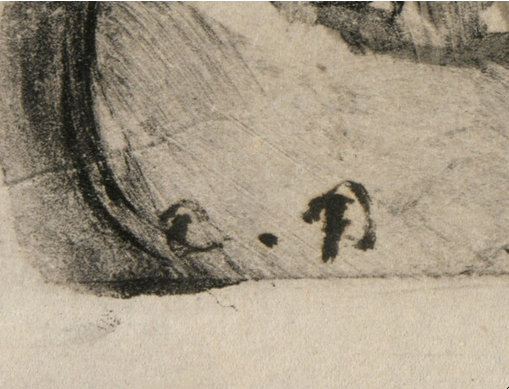The last frontiers in the study of Pissarro’s art are his monoprints (or monotypes), his pastels, and his paintings in gouache and tempera on silk and paper (see fig. 16.1, fig. 16.2 [PV 1348], and fig. 16.3 [PV 1592]). Like that of his friends Edgar Degas and Paul Gauguin, Pissarro’s interest in oil painting was only a part of a much larger and more complex practice fueled, in his case, by a desire to bring art to a much larger public than the wealthy bourgeois élites whose financial support he needed even as he despised their political stance. Pissarro presented prints and drawings in most of the Impressionist exhibitions between 1874 and 1886, and his solo shows at the Durand-Ruel gallery often included more works on paper than oil paintings.
This monoprint, The Market, the only one in the permanent collection of the Art Institute, is unique. Like both Degas and Gauguin, Pissarro seems not to have done what most artists of the time did: pull two or three impressions, keeping the first as a “monoprint” and using the subsequent, paler impressions as “underdrawings” for pastels and watercolors. Rather, his monoprints tend to be just that—single impressions pulled from a brush-and-ink painting on a glass or metal plate that was immediately wiped off (see Media Characteristics in the technical report). He reveled in the possibilities of reversal and the surprises that resulted from this highly unusual process, which became an indispensable component of avant-garde practice in the last decades of the nineteenth century.
This work represents a poultry market in either Pontoise or Gisors, where the artist made studies of such themes in sketchbooks, drawings, and other paintings from the 1870s to the 1890s (see fig. 16.1, fig. 16.2, and fig. 16.3). Clearly, the place itself did not matter to Pissarro, who elected to evoke a tightly packed crowd of people in a large public plaza; the only nonhuman element is a large white awning at the upper right that contrasts with the sea of figures gossiping, haggling, and gazing about. The position of the awning and even certain figures relates the monoprint to the upper-right corner of a signed and dated painting of 1895, reinforcing the accuracy of the Art Institute’s traditional dating (fig. 16.4 [PDRS 1097]).
Indeed, Pissarro made many other monotypes in 1895. It seems that, when the artist turned to a particular medium, he did so repeatedly as part of a campaign; monotypes representing bathers and markets were undoubtedly made quite quickly in series. He used other paintings and drawings as motifs for his monoprints and worked with speed (see Media Characteristics in the technical report). The whole process of creating a monoprint could be accomplished in less than an hour, and this sheet has an air of spontaneity that makes it close to an “impression.” Yet nothing could be further from the case. Pissarro made his monoprints in his studio, modeling them after existing works of art, and the look of spontaneity comes not so much from the freshness of his observation as from the freshness of his technique.
Richard R. Brettell
Technical Report
Technical Summary
Pissarro created The Market, a monotype in black ink, directly on the print matrix with brush and black printing ink. The ink was used more lightly or thinned to create some strokes that appear recessed in the image. The plate was selectively wiped to create tonal variations and highlights in the figures, and then printed onto smooth cream paper (fig. 16.5). The platemark is partially visible, most noticeably along the top margin, just above the image, although it is not possible to determine the type of printing matrix.
Media and Support
Support Characteristics
Primary paper type
Cream, medium-thick, smooth, wove paper.
Paper fabrication
Furnish
Uniform.
Formation
Even; machine-made.
Other characteristics
The deckle is preserved along the top edge, the sides are edge torn, and the bottom edge is trimmed straight.
Dimensions
Image: 130 × 180 mm; plate: 130 × 180 mm (mark not clear); sheet: 155 × 203 mm.
Preparatory Layers
No artistic surface alterations or coatings are visible under normal conditions or under magnification. Under UV radiation there is a pale-yellow visible-light fluorescence overall on the paper surface that is characteristic of a light gelatin surface size.
Media Characteristics
The work is a monotype in black ink. Pissarro created the image directly on the print matrix with brush and black printing ink. He used the ink more lightly and/or thinned it to create some strokes in the background figures, and he selectively wiped the plate to create tonal variations and highlights in the figures. A platemark is partially visible, most noticeably along the top margin, just above the image. There is not enough physical evidence to discern what type of printing matrix (glass or copper) was employed. No media is visible on the verso.
Compositional Development
No revisions or changes are visible in the composition in normal conditions or under magnification.
Surface Treatment
No artistic surface alterations or coatings are visible in normal conditions, under UV radiation, or under magnification.
Condition History
The print exhibits two fine creases, which are evident in the lower left corner and center bottom of the image; these existed in the sheet prior to printing. There are fine folds along the top deckle edge. The side edges were edge torn and display small losses. There is a stray mark of brownish-black ink at the top left corner, at the image edge.
The print was conserved in 2014 for publication. Two small tears at the center and bottom right edge were repaired. Light surface soiling and stray marks were reduced in the sheet margins, and a small brown stain at the lower right margin was also reduced. A vertical center crease and soft undulations, particularly in the image corners due to the pressure from the printing plate, were reduced by pressing; the platemark was preserved.
Kimberly Nichols
Provenance
Dr. Sigmund Pollag (1888–1977), Zurich.
Sold by Dr. Sigmund Pollag, Zurich, through Galerie Wolfgang Ketterer, Munich, Nov. 27, 1973, to C. G. Boerner, Düsseldorf.
Sold by C. G. Boerner, New York, to James Bergquist, Boston, 1974.
Sold by James Bergquist, Boston, to the Art Institute of Chicago, 1987.
